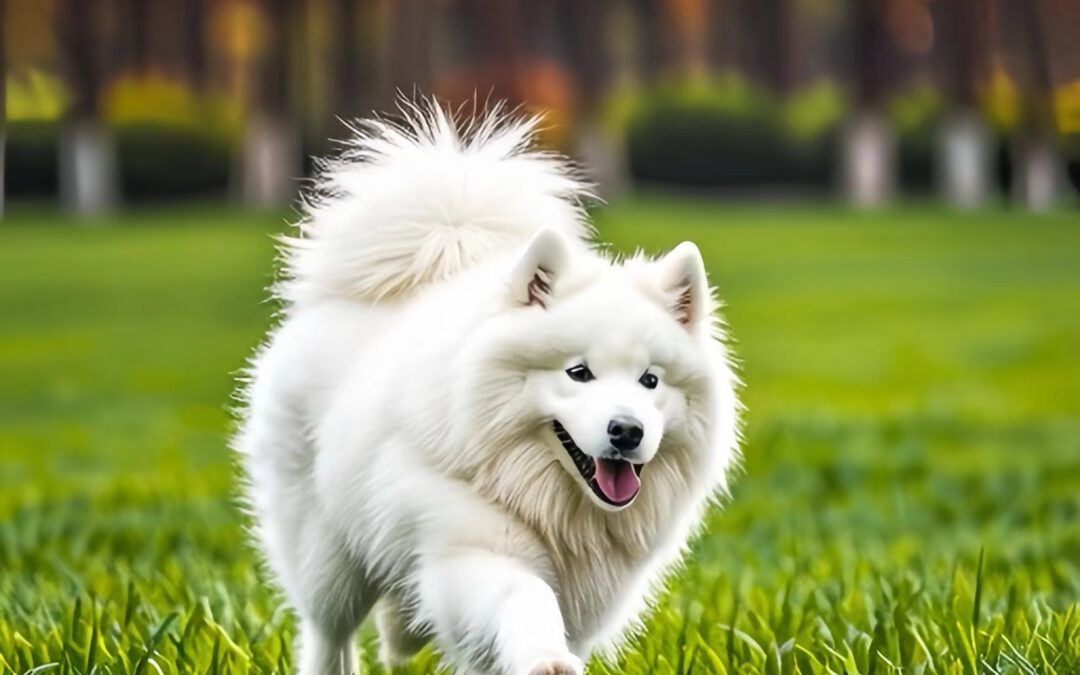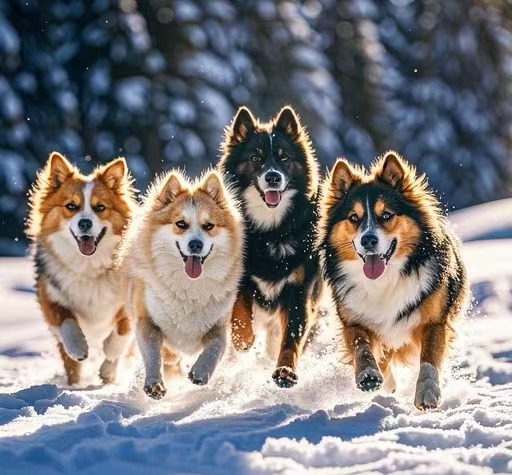
oleh TCMVET | Jun 7, 2024 | Kanker & Tumor Anjing
Ovarian cancer in dogs, though rare, is a serious condition that requires attention. Early detection can greatly improve the prognosis and quality of life for affected dogs. In this article, we’ll explore the causes and early signs of ovarian cancer in dogs, providing valuable information to help you recognize and address this condition promptly.
Causes of Ovarian Cancer in Dogs
Faktor genetik
Genetics play a significant role in the development of ovarian cancer in dogs. Certain breeds are more prone to cancer due to inherited genetic mutations. Breeds such as Golden Retrievers, Boxers, and German Shepherds have shown higher incidences of various cancers, including ovarian cancer.
Hormonal Imbalances
Hormonal imbalances can contribute to ovarian cancer in dogs. Unspayed female dogs are at a higher risk due to prolonged exposure to estrogen. Spaying your dog can significantly reduce the risk by eliminating the primary source of estrogen.
Usia
Older dogs are more commonly diagnosed with ovarian cancer. As dogs age, their cells are more likely to undergo mutations that can lead to cancer. Regular veterinary check-ups are crucial for early detection, especially as your dog gets older.
Environmental Exposure
Exposure to environmental toxins and carcinogens can increase the risk of ovarian cancer in dogs. This includes exposure to secondhand smoke, pesticides, and industrial chemicals. Keeping your dog’s environment clean and minimizing exposure to harmful substances can help reduce this risk.
Early Signs of Ovarian Cancer in Dogs
Recognizing the early signs of ovarian cancer in dogs is essential for timely intervention. Here are some common symptoms to watch for:
Abdominal Swelling
One of the most noticeable early signs of ovarian cancer in dogs is abdominal swelling. This can result from the tumor itself or from fluid accumulation in the abdomen (ascites). If your dog’s abdomen appears unusually enlarged, seek veterinary care immediately.
Lethargy and Weakness
Dogs with ovarian cancer often exhibit lethargy and weakness. They may become less active, sleep more than usual, and lose interest in their favorite activities. This change in behavior can be subtle but is significant.
Penurunan Berat Badan
Unexplained weight loss is another early sign of ovarian cancer in dogs. Despite having a normal or increased appetite, affected dogs may lose weight due to metabolic changes caused by the cancer.
Changes in Appetite
Changes in appetite, including both increased and decreased eating habits, can indicate ovarian cancer. Some dogs may refuse food altogether, while others may seem hungrier than usual but still lose weight.
Vomiting and Diarrhea
Gastrointestinal issues such as vomiting and diarrhea are common in dogs with ovarian cancer. These symptoms can be intermittent or persistent and are often accompanied by other signs of illness.
Abnormal Vaginal Discharge
In female dogs, abnormal vaginal discharge can be an early sign of ovarian cancer. This discharge may be bloody or pus-like and can occur regardless of the dog’s reproductive status.
Perubahan Perilaku
Behavioral changes, such as increased irritability or depression, can also be early indicators of ovarian cancer in dogs. These changes often result from the discomfort and pain caused by the tumor.
Kesimpulan
Understanding the causes and early signs of ovarian cancer in dogs is essential for pet owners. Early detection and intervention can make a significant difference in the outcome for affected dogs. If you notice any of the symptoms mentioned above, consult your veterinarian for a thorough examination and appropriate diagnostic tests.
By staying informed and vigilant, you can help ensure your dog receives the best possible care and maintain their quality of life. Remember, regular veterinary check-ups and preventive measures, such as spaying, play a vital role in safeguarding your dog’s health against ovarian cancer.
For more information on dog health and holistic treatments, visit our blog at TCMVET, where we provide cutting-edge research and insights into natural supplements and cancer care for pets.

oleh TCMVET | Jun 7, 2024 | Kanker & Tumor Anjing
As a pet owner, discovering a sudden lump under your dog’s skin can be alarming. These unexpected growths can vary in size, shape, and texture, and while some may be harmless, others can indicate serious health issues. This article will guide you through understanding the potential causes of sudden lumps, the importance of early detection, and the treatment options available.
Common Causes of Sudden Lumps in Dogs
- Lipoma: These are benign fatty tumors commonly found in older dogs. They are generally soft, movable, and painless.
- Cysts: These fluid-filled sacs can form due to blocked hair follicles or oil glands. They may rupture and need medical attention.
- Abses: Infections can lead to abscesses, which are painful, pus-filled lumps often caused by bites, scratches, or wounds.
- Hematomas: These are blood-filled swellings resulting from trauma or injury, often seen in the ears or other areas prone to bruising.
- Tumor Sel Mast: These cancerous lumps can appear suddenly and grow quickly. They require immediate veterinary assessment and treatment.
- Sebaceous Adenomas: These are benign tumors arising from sebaceous glands, often appearing as wart-like lumps on the skin.
Pentingnya Deteksi Dini
Early detection of lumps in dogs is crucial for several reasons:
- Preventing Complications: Identifying lumps early can prevent them from growing or causing other health issues.
- Determining Malignancy: Early diagnosis helps determine if a lump is benign or malignant, allowing for prompt treatment if needed.
- Improving Prognosis: Timely intervention can improve the prognosis for dogs with cancerous lumps, increasing the chances of successful treatment.
Steps to Take if You Discover a Lump
- Observe the Lump: Note the size, shape, texture, and any changes over time. Keep track of any other symptoms your dog may exhibit, such as lethargy, loss of appetite, or changes in behavior.
- Consult Your Veterinarian: Schedule an appointment with your vet to have the lump examined. Your vet may perform a fine needle aspiration (FNA) or biopsy to determine the nature of the lump.
- Follow Through with Recommended Tests: Depending on the initial findings, additional tests such as blood work, X-rays, or ultrasound may be necessary to get a complete picture of your dog’s health.
Treatment Options for Sudden Lumps
The treatment for lumps in dogs varies depending on the underlying cause:
- Operasi pengangkatan: Benign and malignant tumors may require surgical excision. In some cases, this is curative, while in others, it may be part of a broader treatment plan.
- Obat-obatan: Antibiotics or anti-inflammatory medications may be prescribed for infections or abscesses. For some tumors, chemotherapy or radiation therapy might be recommended.
- Holistic and Natural Treatments: Supplements like TCMVET Baituxiao and Turkey Tail mushrooms have shown promise in managing tumors naturally and supporting overall pet health. Always consult your vet before starting any new treatment regimen.
Preventive Measures and Monitoring
- Pemeriksaan Reguler: Schedule regular veterinary check-ups to monitor your dog’s health and catch any potential issues early.
- Healthy Diet and Exercise: Maintain a balanced diet and regular exercise routine for your dog to support their overall health and immune system.
- Regular Grooming and Inspections: Regular grooming and skin inspections can help you notice any new lumps or changes in your dog’s skin condition.
Kesimpulan
While discovering a sudden lump under your dog’s skin can be concerning, understanding the potential causes and seeking prompt veterinary advice can make a significant difference in your pet’s health. Early detection and appropriate treatment are key to managing these lumps effectively. Remember to stay vigilant, consult your vet, and explore all treatment options, including natural supplements, to ensure the best care for your furry friend.
Tags: Dog Health, Sudden Lumps in Dogs, Lipomas in Dogs, Canine Cysts, Dog Abscess Treatment, Mast Cell Tumors in Dogs, Veterinary Oncology, Holistic Treatments for Dogs, Natural Supplements for Dogs, TCMVET Baituxiao, Turkey Tail Mushrooms for Dogs.

oleh TCMVET | Jun 7, 2024 | Kanker & Tumor Anjing
Stomach cancer in dogs, though relatively rare, can be a devastating diagnosis for pet owners. Early detection and comprehensive care are crucial in managing this disease. In this article, we will explore the symptoms, diagnosis, and treatment options for stomach cancer in dogs, providing valuable insights to help pet owners navigate this challenging journey.
Symptoms of Stomach Cancer in Dogs
Stomach cancer, also known as gastric cancer, often presents with subtle and non-specific symptoms that can be easily overlooked. Recognizing these signs early can significantly improve the prognosis for your furry friend. Common symptoms include:
- Kehilangan selera makan: A noticeable decrease in your dog’s interest in food is often one of the first signs.
- Penurunan Berat Badan: Rapid or unexplained weight loss can be a cause for concern.
- Muntah: Frequent vomiting, especially if it contains blood, should be addressed immediately.
- Kelesuan: A general lack of energy and enthusiasm for activities they once enjoyed.
- Abdominal Pain: Signs of discomfort when their abdomen is touched or a change in posture to avoid pressure on the stomach.
Diagnosing Stomach Cancer in Dogs
If you observe any of the aforementioned symptoms, it is essential to consult a veterinarian promptly. The diagnostic process may involve several steps to confirm the presence of stomach cancer:
- Pemeriksaan fisik: The vet will conduct a thorough physical check-up to identify any abnormalities.
- Blood Tests: These tests can help identify any underlying issues and provide insight into the dog’s overall health.
- Pencitraan: X-rays, ultrasounds, and endoscopic examinations can reveal tumors or irregularities in the stomach.
- Biopsi: A definitive diagnosis often requires a biopsy, where a small sample of stomach tissue is taken for laboratory analysis.
Treatment Options for Stomach Cancer in Dogs
The treatment plan for stomach cancer in dogs depends on various factors, including the stage of the cancer, the dog’s overall health, and the specific type of tumor. Common treatment options include:
- Operasi: Surgical removal of the tumor is often the most effective treatment, especially if the cancer is detected early and is localized.
- Kemoterapi: This can be used in conjunction with surgery or as a standalone treatment to manage cancer cells and prevent further spread.
- Terapi radiasi: Less commonly used for stomach cancer, radiation therapy may still be an option depending on the tumor’s location and size.
- Holistic Treatments: Integrative approaches, such as dietary changes, herbal supplements like TCMVET Baituxiao, and acupuncture, can support conventional treatments and enhance the dog’s quality of life.
- 姑息治疗:在严重的情况下,重点可能会转移到姑息治疗,以确保狗保持舒适且无痛。
Preventing Stomach Cancer in Dogs
While it is not always possible to prevent stomach cancer, maintaining your dog’s overall health through a balanced diet, regular exercise, and routine veterinary check-ups can reduce the risk of many diseases, including cancer. Additionally, being vigilant about any changes in your dog’s behavior or health and seeking prompt veterinary care can aid in early detection and treatment.
Kesimpulan
Stomach cancer in dogs is a serious condition that requires prompt attention and a comprehensive treatment approach. By understanding the symptoms, diagnostic procedures, and treatment options, pet owners can play a crucial role in managing their dog’s health and well-being. If you suspect your dog may have stomach cancer, consult with a veterinarian immediately to explore the best course of action.
For more information on natural supplements and holistic treatments for dogs with cancer, visit our blog at TCMVET. We are dedicated to providing the latest research and resources to help you support your pet’s health naturally.

oleh TCMVET | Jun 6, 2024 | Makanan & Kesehatan
Methionine, an essential amino acid, is garnering attention for its potential role in cancer treatment for dogs. While traditionally recognized for its contributions to liver function, detoxification, and overall metabolic health, recent studies suggest methionine might offer benefits for dogs battling cancer. This article explores the unique potential of methionine in canine cancer care, its benefits, proper dosage, and considerations for pet owners.
What is Methionine?
Methionine is an essential amino acid, meaning it must be obtained through diet as the body cannot synthesize it. It plays a crucial role in various biological processes, including:
- Protein synthesis
- Detoksifikasi
- Methylation (a process crucial for DNA repair and gene regulation)
- Antioxidant production
Potential Benefits of Methionine for Dogs with Cancer
- Sifat Anti Kanker: Methionine restriction has been studied for its potential to inhibit cancer cell growth. Cancer cells often rely heavily on methionine, and reducing its availability might slow tumor progression.
- Detoksifikasi: Methionine supports the production of glutathione, a powerful antioxidant that helps detoxify harmful substances in the body, potentially reducing the oxidative stress associated with cancer.
- Dukungan Kekebalan Tubuh: Adequate methionine levels can support a healthy immune system, which is vital for dogs fighting cancer.
Dosis dan Administrasi
Determining the appropriate dosage of methionine for dogs with cancer should be done under veterinary supervision. General guidelines include:
- Konsultasi: Always start by consulting with your veterinarian to assess your dog’s specific needs and health status.
- Dietary Sources: Methionine is naturally present in high-protein foods like meat, fish, and eggs. A balanced diet can help meet your dog’s methionine requirements.
- Supplementation: If supplementation is necessary, your vet can recommend a suitable product and dosage based on your dog’s weight, health condition, and specific cancer type.
Studi Kasus dan Kisah Sukses
Several anecdotal reports and preliminary studies suggest that methionine supplementation, combined with other cancer treatments, may help improve outcomes for dogs with cancer. Pet owners have observed improvements in their dogs’ energy levels, appetite, and overall well-being.
Tindakan Pencegahan dan Pertimbangan
- Veterinary Supervision: Always administer methionine under the guidance of a veterinarian to ensure proper dosing and to avoid potential side effects.
- Diet seimbang: Ensure your dog receives a well-balanced diet to avoid deficiencies in other essential nutrients.
- Pemantauan Reguler: Regular veterinary check-ups are crucial to monitor your dog’s health and adjust the treatment plan as needed.
Kesimpulan
Methionine holds promise as a supportive treatment for dogs with cancer. Its potential to inhibit cancer cell growth, support detoxification, and boost the immune system makes it a valuable addition to a comprehensive cancer treatment plan. As with any supplement, proper veterinary guidance is essential to ensure safety and effectiveness.






